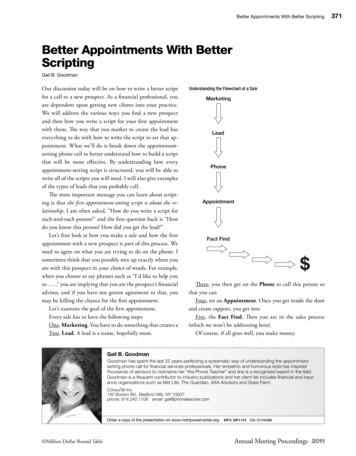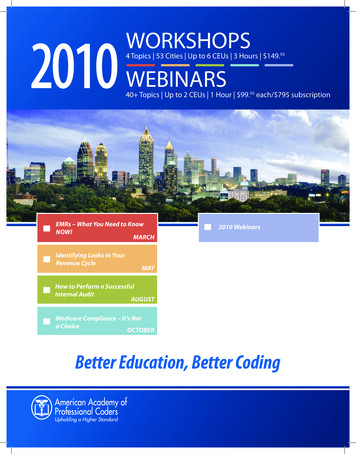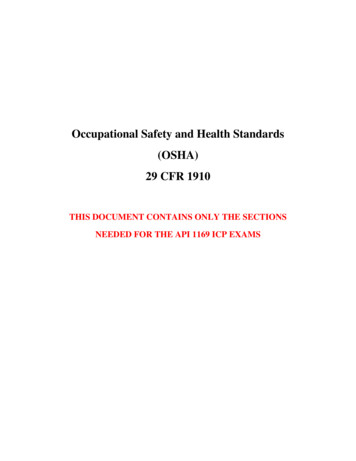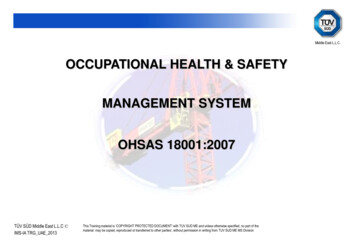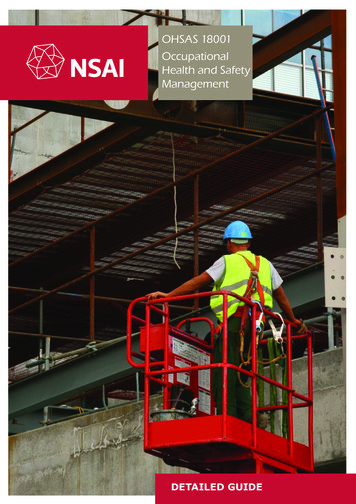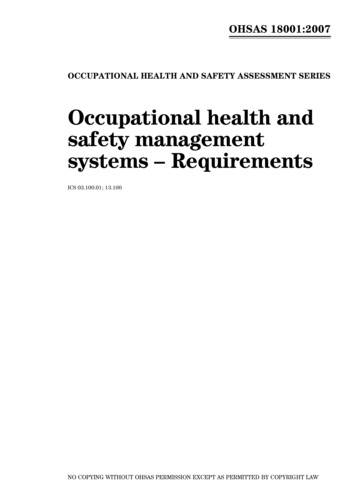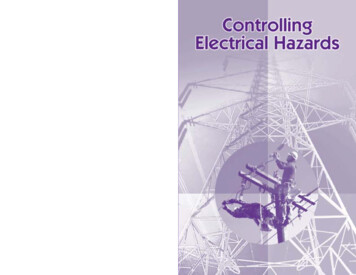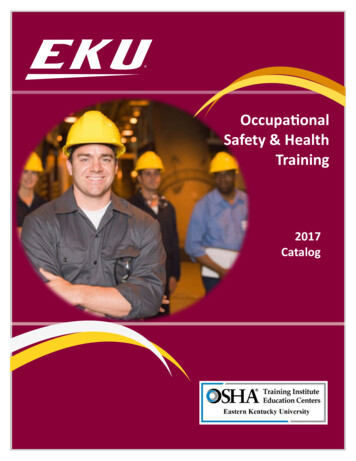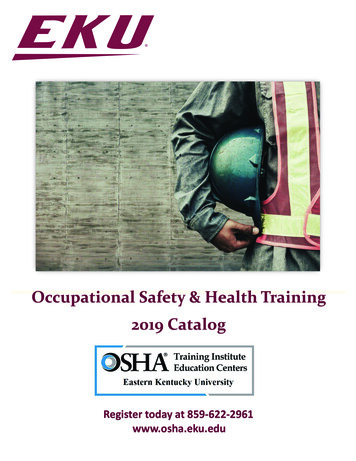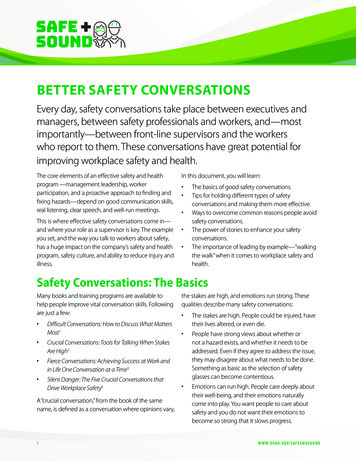
Transcription
BETTER SAFETY CONVERSATIONSEvery day, safety conversations take place between executives andmanagers, between safety professionals and workers, and—mostimportantly—between front-line supervisors and the workerswho report to them. These conversations have great potential forimproving workplace safety and health.The core elements of an effective safety and healthprogram —management leadership, workerparticipation, and a proactive approach to finding andfixing hazards—depend on good communication skills,real listening, clear speech, and well-run meetings.This is where effective safety conversations come in—and where your role as a supervisor is key. The exampleyou set, and the way you talk to workers about safety,has a huge impact on the company’s safety and healthprogram, safety culture, and ability to reduce injury andillness.In this document, you will learn: The basics of good safety conversations.Tips for holding different types of safetyconversations and making them more effective.Ways to overcome common reasons people avoidsafety conversations.The power of stories to enhance your safetyconversations.The importance of leading by example—“walkingthe walk” when it comes to workplace safety andhealth.Safety Conversations: The BasicsMany books and training programs are available tohelp people improve vital conversation skills. Followingare just a few: Difficult Conversations: How to Discuss What MattersMost1 Crucial Conversations: Tools for Talking When StakesAre High2 Fierce Conversations: Achieving Success at Work andin Life One Conversation at a Time3 Silent Danger: The Five Crucial Conversations thatDrive Workplace Safety4A “crucial conversation,” from the book of the samename, is defined as a conversation where opinions vary,1the stakes are high, and emotions run strong. Thesequalities describe many safety conversations: The stakes are high. People could be injured, havetheir lives altered, or even die. People have strong views about whether ornot a hazard exists, and whether it needs to beaddressed. Even if they agree to address the issue,they may disagree about what needs to be done.Something as basic as the selection of safetyglasses can become contentious. Emotions can run high. People care deeply abouttheir well-being, and their emotions naturallycome into play. You want people to care aboutsafety and you do not want their emotions tobecome so strong that it slows progress.WWW.OSHA.GOV/SAFEANDSOUND
To make these conversations successful, you needto make sure workers feel safe expressing their viewsand know that you care about their welfare. If workersfeel threatened, they are unlikely to fully participate inthe discussion, learning will be stifled, and change isless likely. Remind workers they will not get in troublefor talking to you, and that your policy allows themto raise safety and health concerns without fear ofreprisal; where applicable, suggest they can have alabor representative present. When conversationsheat up, try to be calm, rational, and open-minded.Avoid insults, personal attacks, direct criticism, andthreatening gestures. State your intentions clearly: thatyou are trying to help them avoid injury and illness, andthe devastating consequences of an injury to them,their co-workers, their future, and their family. Repeat asoften as needed.Ways to Begin a Safety Conversation“I’d like to talk to you about something important.Let’s review the safest way to do this task, so you andyour team are not at risk of getting hurt.”“I respect your experience and want to make surenobody is injured, so I’d like to work with you toaddress this issue.““Can we talk about what I’m seeing and figure out abetter way to do it?”Tips for Different Types of Safety ConversationsExpect to have several informal types of safety conversations as you work to engage the workforce andimplement your safety and health program. These include the walk-around conversation, the “elevator speech,”and the feedback safety conversation. Formal conversations will also occur in scheduled meetings on the topic,but be prepared to discuss safety topics during the following informal conversations.Type 1: The Walk-Around ConversationThis conversation occurs when an executive, mid-levelmanager, or safety professional is walking through thefacility or jobsite with workers. It could be a regularsafety inspection, an executive walk-around to displaysafety management leadership, or a non-safety walkaround where safety issues arise. The key to successfulconversations in this setting is establishing two-waydialogue, and, above all, good listening. Ask theworkers an open-ended question, and then really listento what they tell you.Your questions could be: “What is your biggest safety concern with thistask?” “What can we do to make this task safer?” “If you could address one safety concern—say, bybuying equipment, changing a work process, orchanging a work rule—what would it be?”2Then ask clarifying questions and engage the worker. “Do you have any ideas that would help us do itbetter?” “Have you seen an incident caused by the issue?” “Has anybody been hurt, or narrowly avoidedgetting hurt?” “Would you be willing to help by being on a taskforce to look at the issue?”Active ListeningUse active listening techniques to help youunderstand the person’s message and build empathy: Mirror or repeat what the person is telling you Paraphrase the message Summarize content Ask for clarification Acknowledge feelings Avoid reacting with criticismWWW.OSHA.GOV/SAFEANDSOUND
Address workers’ actions that are unsafe withoutcriticizing the workers, but also praise what they aredoing right and ask questions about what they mightdo differently to ensure safety. Make sure you capturethese items with notes. Look for actionable items andfollow up, either yourself or by assigning the issue to asafety committee or responsible manager. If you decidethat further action is not needed, tell the employeewhy you have made that decision. If you have theseconversations, listen well, and follow up with realaction, you can make it clear to workers that you areserious about safety.Focus on the PositiveTry to emphasize the positive aspects of your program.Effective safety and health programs can improve: Product, process, and service quality. Workplace morale. Employee recruiting and retention. Image and reputation among customers,suppliers, and the community.Type 2: The “Why I Care about Safety” Elevator SpeechThis conversation usually happens when somebodyasks you why you care about safety, and you shouldoffer your perspective whenever the opportunityarises. It is important that you have an immediate,concise answer. Just as an elevator ride will last only aminute or two, this speech should be short and to thepoint. Explain why you care about safety, share yourexperience, give some statistics, or tell a personal story.Here is a sample speech.There are three reasons why I care about safety in ourworkplace: “Last year we had five injuries. Those didn’t haveto happen. When I see the injury reports, my heartgoes out to the workers and their families, and Iwant to do what I can to see it doesn’t happen tosomebody else.” “I looked up the injury statistics and found thatthousands of workers are injured in our industry. Ithink our industry should be a leader in protectingits workers, and I want us to do our part.” “The importance of safety really hit home for mewhen one of my uncles was seriously injured onthe job. I saw for myself the suffering he wentthrough and the impact it had on our family. I wantto make sure it doesn’t happen to our workers andtheir families.”Type 3: The Safety Feedback ConversationGiving feedback is one of the most common safetyconversations. Constructive feedback is needed toimprove safety. Feedback that comes in the form ofcriticism can make people defensive. Managers oftenavoid giving feedback in order to avoid confrontations.In Thanks for the Feedback: The Science and Art ofReceiving Feedback Well, Douglas Stone and SheilaHeen suggest giving just one of three differenttypes of feedback at a time: appreciation, coaching,or constructive feedback.5 You will likely be moresuccessful if you give only one type of feedback in asingle session; giving different types can confuse the3person you are giving feedback to and dilute yourmessage.Appreciation, or positive feedback, is an importantfeedback tool. Research indicates that negativefeedback is two to four times more powerful thanpositive feedback (but in a negative way). If you wantto promote a positive environment, limit negativefeedback and give twice as much positive feedback.Praise with enthusiasm, criticize lightly. When givingappreciation, thank the person for doing somethingpositive for safety. For example:WWW.OSHA.GOV/SAFEANDSOUND
“I really appreciate the way you brought up thesafety issue without getting people upset.”“Thanks for pointing out that safety issue. Youractions could keep somebody from getting hurt.”“Thanks for repairing the equipment quickly. Itshows all of us that safety is important.”Coaching is another helpful form of feedback, especiallywhen the person is motivated, cares about safety, andis willing to work on your safety and health program. Itis a positive form of feedback that can take two forms:performance coaching and leadership coaching. Performance coaching is much like coachingsports skills. You model the activity; observe theperson you are coaching; and give feedback onwhat was right, what was wrong, and what couldbe improved. Then repeat until the person gets itright. Leadership coaching asks open-ended questionsand lets workers find their own solutions toproblems. Some questions you might ask include:ºº“How do you think we should address thissafety issue?”ºº“What kind of hazard controls would help usavoid this problem in the future?”ºº“Personal protective equipment (PPE) isprovided to protect you from specific hazards.What else is important to you when selectingPPE?”When coaching, you may also want to help the personbrainstorm alternatives and stay on topic. The moredifficult the question, the easier it is to veer off intoother subjects. Use questions to ensure safety issuesare addressed:4 “How can we improve this task?” “Will you work with me to create an action plan tomake sure this doesn’t fall through the cracks?” “Will you make a commitment to work with me onthis issue?”Constructive feedback should be used whenperformance is not meeting expectations, and youhave specific feedback to correct the situation. Thegoal is to improve and make a given situation better.To achieve this goal, the feedback session and thefeedback giver need to approach it in a positiveway that will motivate the feedback receiver. Avoidjudgmental statements and personal criticisms. Focuson the behavior, not on the person or his or her valuesor personality. Remember that the feedback receiverhas the option to accept or reject your feedback.Several methods for providing feedback can help youimprove these conversations. One method uses the“COIN” method, described in The Feedback Imperative.6Another method that combines some elements ofconstructive feedback and coaching is the “Ask-Tell-Ask”method. (See box on page 5 for details.)No matter what feedback type or method you use,you will need to follow up and see if the strategiesare working and behaviors have changed. Frequentlyupdate workers on the status of their safetysuggestions and/or reports of hazards they havesubmitted. Inform them as soon as their concernshave been addressed, or explain if their suggestionscannot be implemented. A common reason workersdo not report safety hazards is because they never geta response.WWW.OSHA.GOV/SAFEANDSOUND
Two Methods for Constructive FeedbackThe COIN MethodConnect: Find common ground with the feedbackreceiver and the feedback topic. “Can we agree that we both care about safety?”“Safety matters to me, does it matter to youtoo?”“My family expects me to work safely so I comehome in one piece. Do you have a family?”Observations: Make specific, accurate descriptions ofthe observed behavior. “I see you aren’t wearing your safety glasses.”“You were working on a machine withoutlocking it out.”“You manually lifted a patient without a patientlift.”Impact: Describe the consequences of the behavior. “You could get something in your eye and needto go to the emergency room.”“The machine could have started and you wouldhave been badly injured.”“If you keep lifting patients without help, you willinjure your back. Many of these injuries result inpermanent disability.”Next steps: Partner with the person to developan action plan or behavior change to improveworkplace safety. 5Let’s make sure your safety glasses fit properlyand meet your needs. Come to my office and wecan look at different models that protect youreyes.”“You are saying you have forgotten the workprocedures. Let’s pause on this activity and I’mgoing to enroll you in a lockout/tagout refresherclass to make sure you understand the properprocedures and know what to do in the eventan incident occurs.”“You couldn’t find the patient lift? Let’s makesure we’re keeping it where you can access it ifneeded.”The “Ask, Tell, Ask” MethodFirst, ask the worker to assess their own performance.This begins a conversation, promotes reflection, andhelps you assess the person’s self-awareness, level ofinsight, and stage of learning. “How did the safety training go? Do youunderstand the procedure now?”“How did the new safety procedure work? Wereyou able to follow it?”“That was a heated safety committee meetingtoday. How do you feel you handled theconversation?”Then, tell what you observed. React to the worker’sobservation, give them some feedback on their selfassessment, and include both positive and correctiveelements. “Thank you for your insights. I saw how you werereally engaged during the PPE module. It alsolooked like you had a harder time learning thefire protection material.”“You were paying good attention. I saw many ofthe same things. I observed the team followingthe first two parts of the procedure. It alsolooked to me like they didn’t follow the last partproperly.”“I think the meeting went fairly well, too. Thediscussion about new high visibility gear wentreally well. Unfortunately, the discussion aboutforklift training wasn’t as productive.”End by asking about the worker’s understanding andstrategies for improvement. Discuss what the workercould do differently. Give your own suggestions andcommit to monitoring improvement together. “How can you make sure you understand our fireprevention program?”“Do you have any ideas for adjusting the last partof the new procedure?”“How could we handle the forklift discussionbetter when it comes up at next month’smeeting?WWW.OSHA.GOV/SAFEANDSOUND
The Conversation That Doesn’t HappenA serious concern is that many safety conversations just don’t happen. People remain silent instead of speakingup about a safety concern. The authors of Crucial Conversations and their colleagues conducted a survey of 1,500workers in 22 organizations,which found that 93 percent of employees say their workgroup is currently at riskfrom a safety issue that is not being discussed.7 Almost half knew of an injury that happened because someonedidn’t speak up. These are incidents waiting to happen. Encouraging people to speak up when they seesomething going wrong can help avoid incidents, injuries, and fatalities. “If you see something, say something” isa saying we have all learned when travelling, and it also applies to safety.The Vital Smarts survey found five types of rationalizations, identified below, that people use to avoid safe workpractices and that kill the right conversation about safety. Here are a few ideas for dealing with these excuseswhen you encounter them.“Get It Done”—unsafe practices that are justified by theneed to meet deadlines. Explain that deadlines aren’t the only thing thatmatters. It is also important to do quality work, andto do the work safely. “If you do not follow the safety procedures, weare more likely to have a serious incident wherepeople are injured and property is destroyed. If thathappens, we will have to stop production and notmeet the deadline. Doing the job safely can helpmake sure you make the deadline.” “In my opinion, no deadline is worth an injury. Thecost is just too high.”“We Can’t Talk About That”—unsafe practices thatstem from skill deficits that can’t be discussed. Try to address the topic with non-judgmentalsuggestions. “I think we could do this job better and more safelyif we all took some refresher training.” “I don’t think he’s learned how to do this yet, andmay not be the best person for this task. Otherpeople on our team have more experience andknowledge about this and can keep us fromgetting hurt.” “Incidents occur very quickly and with no warning.You don’t know if the next time is the time you willbe unlucky and it will go wrong.”“If you use the justification that it is just this once,you are more likely to use that reasoning again. Itwon’t be once, and it could become all the time.”“This Is Overboard”—unsafe practices that bypassprecautions considered excessive. Try to focus on avoiding injury. Explain that the rulewas put in place for a reason. “There is a process forchanging rules, and that may be a better way todeal with it.” “I think the rule was put in place because ofan incident where workers were injured, someof them seriously. We should just follow theprocedure so we don’t get hurt too.” “If you don’t think the procedure is necessary, weshould try to change it. Until then, we should try tofollow it as closely as possible.”“Just This Once”—unsafe practices that are justified asexceptions to the rule. Explain that it only takes one time to get hurt, andthat this excuse is too easy to use again and again.Just one time can become the usual way of doingthings.“Are You a Team Player?”—unsafe practices thatare justified for the good of the team, company, orcustomer. Focus on the wellness of the team, and how unsafepractices can hurt the team. “I think of myself as a team player, and I want tomake sure the team is kept safe. I don’t want to seeany of my team members get hurt.” “I’ve been working with these people for years, andI know many of their families. I don’t want to see aninjury affect their future life.”6WWW.OSHA.GOV/SAFEANDSOUND
The Power of StoriesStorytelling can be a useful skill in any conversation orspeaking opportunity. Telling a short, compelling storydescribing a real event is a persuasive way to reinforceyour safety program. The story should be short, just afew sentences delivered in 15 to 20 seconds. “I knew a worker who was injured doing that onthe job. After a few surgeries and three monthsof recovery, he managed to come back to work.Unfortunately, he was never the same. The traumaof the event impacted his confidence and he justcouldn’t do things he did before.” “Last year we had three workers who injuredtheir backs—one of them so badly that they arepermanently disabled and will never be able towork again.” “The Bureau of Labor Statistics reported that 20people died in trench collapses last year. I don’twant to see that happen to our workers.”Collect stories, and know about incidents that haveoccurred in your workplace, your company, and yourindustry. Do your research about injuries, illnesses, andfatalities that have occurred to workers in your industryor do the same work that you do. Follow the newsso you can use a current event in your area. Storiesthat are fresh and close to you have more power. Usethe webpages for OSHA, the National Institute forOccupational Safety and Health, and the Bureau ofLabor Statistics to collect statistics and stories aboutworkplace incidents. Talk to your insurance carrier,which might have good stories you can use.Set a Good ExampleLeadership by example is the strongest way toencourage workers to engage in your safety and healthprogram, to work safely, and use PPE.8 Walk the walkby using the right PPE, following safe work procedures,and promoting the safety and health program; thishelps set an example and further your safety goals.The way you communicate also sets an example.Raising sensitive safety issues with skill, respect, anda caring attitude shows other workers how to do thesame. Make sure that you accept constructive feedbackwell, ask for feedback often, and handle negativefeedback with grace.You can improve your safety and health program by improving your safety conversations. Experiment withdifferent approaches, build a library of safety phrases and stories, and have these conversations without fear. Bydoing so, you can contribute to preventing injuries.1 Difficult Conversations, Douglas Stone, Bruce Patton, Sheila Heen2 Crucial Conversations, Skills for Talking When the Stakes Are High, Kerry Patterson, Joseph Grenny, Ron McMillan, Al Switzer3 Fierce Conversations, Susan Scott4 Silent Danger, The Five Crucial Conversations that Drive Workplace Safety, www.vitalsmarts.com/ safety5 Thanks for the Feedback, the Science and Art of Receiving Feedback Well, Douglas Stone and Sheila Heen6 The Feedback Imperative, Anna Caroll, MSSW7 anger-93-percent-of- ccidents/8 The Differential Effects of Transformational Leadership Facets on Employee Safety, Safety Science Volume 62, February 2014,Pages 68–78; Volume 62, February 2014, Pages 68–78.7
Silent Danger: The Five Crucial Conversations that Drive Workplace Safety4 A “crucial conversation,” from the book of the same name, is defined as a conversation where opinions vary, the stakes are high, and emotions run strong. These qualities describe many safety conversations
